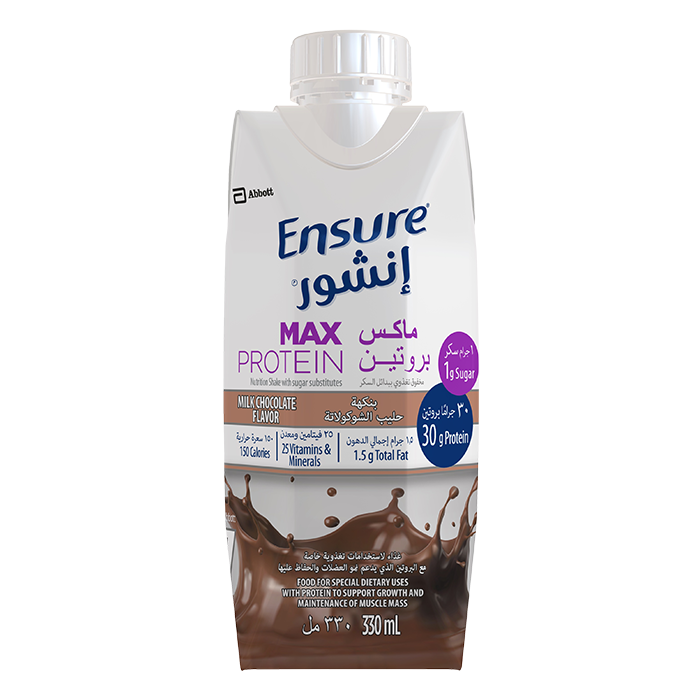Ensure Complete
- Main Image
-

- Subtitle
- For complete balanced nutrition
- Title
- Ensure® Complete
- Detail Page Path
Identifies early signs of sarcopenia, such as muscle weakness and difficulty with daily activities. Early detection aids effective management.
Discusses the benefits of resistance-based exercises using bands or weights. Regular activity, including walking, helps maintain muscle strength.
Provides information on the importance of oral nutritional supplements with protein and HMB. These support muscle building and prevent muscle loss, especially in older adults.
The MENA region, like many parts of the world, is experiencing a demographic transition with an increasing aging population. The median age across the MENA region is 29.6 years old1, indicating a younger population overall, but the population is aging due to factors such as improved healthcare leading to higher life expectancy and lower infant mortality rates. This demographic shift towards an older population is creating new challenges for healthcare systems, including the management of age-related conditions such as sarcopenia.2,3
Have you checked on your muscle health lately? The first thing to do is to find out if you are at risk of sarcopenia and if you need to strengthen the muscles. You can use the adapted version of the self-screening questionnaire, called SARC-F, below. Find out if you or your loved one is at risk of sarcopenia.
Strength, Assistance in walking, Rise from a chair, Climb stairs, Falls
How much difficulty does the patient have in lifting and carrying 4.5 kg?*
How much difficulty does the patient have in walking across a room?*
How much difficulty does the patient have transferring from a chair or bed?*
How much difficulty does the patient have climbing a flight of 10 stairs?*
How many times has the patient fallen in the past year?*
Result: LOW SARCOPENIA RISK
You may be at risk of muscle loss but it’s not too late to start improving your muscle health now. Speak to your doctor to find out how to improve your muscle health through nutrition and exercise. Act now to live life strong!
Result: NO SARCOPENIA RISK
You don't seem to be at risk for sarcopenia. If you are concerned, please consult with a doctor.
Once you are done with the self-assessment, there are 3 main changes that you can make to your lifestyle to treat or prevent sarcopenia.
Start practicing resistance-based exercises, using resistance bands or weights. Walking and keeping active are also key to maintain a healthy lifestyle. Every day is key. It is better to do a little bit every day, than one big session once a week.
Studies have shown that in order to maintain muscle mass and muscle health as we age, we need more protein in our diet. In addition, HMB (β-hydroxy-β-methylbutyrate), which supports muscle building and prevents muscle loss, when taken as part of an oral nutrition supplement, may be beneficial for building and preserving muscle mass in older adults, according to the SHIELD Study4 , by Changi General Hospital (CGH), SingHealth Polyclinics (SHP), and Abbott. In fact, adults with malnutrition risk who consumed two glasses of an oral nutritional supplement with HMB and were supported with dietary counselling were 3x more likely to have lower nutritional risk; significantly improved leg strength at 90 days and significantly improved handgrip among females at 180 days.
HMB is a leucine metabolite that helps counteract muscle loss. It is present in small quantities in foods such as avocados, citrus fruit, broccoli, cauliflower, asparagus, eggs and beef. Although leucine is found in food, adequate HMB is difficult to get from the diet alone. It is also known that levels of HMB in the body, may decrease with age.
Vitamin D is vital to maintain normal muscle function. You need 600-800 IU/Day of Vitamin D. Get your daily dose of sunshine! Step outside and enjoy the sun. The SHIELD study has also shown that the consumption of 2 servings of the specialised ONS with HMB daily, improved Vitamin D levels.
Take the SARC-F test today and make it a family habit to live life strong. It is never too late to start improving your muscle health.
References:
1. https://www.statista.com/topics/5242/demographics-in-mena/ - as accessed on 26 May, 2024
2. https://www.sciencedirect.com/science/article/pii/S1319562X20306239 - as accessed on 26 May, 2024
3. https://www.ncbi.nlm.nih.gov/pmc/articles/PMC9099718/ - as access on the 26th May, 2024
Chew, S.T.H., Kayambu, G., Lew, C.C.H. et al. Singapore multidisciplinary consensus recommendations on muscle health in older adults: assessment and multimodal targeted intervention across the continuum of care. BMC Geriatr 21, 314 (2021). https://doi.org/10.1186/s12877-021-02240-8



ANI-OMN-MN-2024-4426
You are about to exit for another Abbott country or region specific website.
Please be aware that the website you have requested is intended for the residents of a particular country or region, as noted on that site. As a result, the site may contain information on pharmaceuticals, medical devices and other products or uses of those products that are not approved in other countries or regions.
The website you have requested also may not be optimized for your specific screen size.
Do you wish to continue and exit this website?